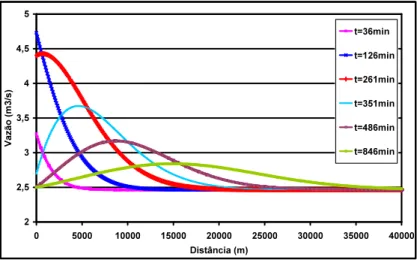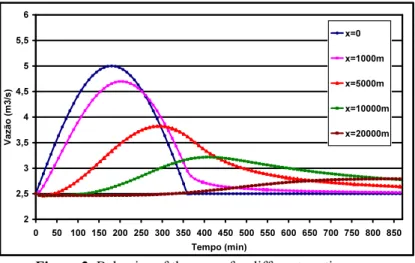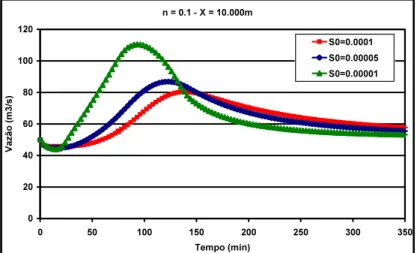114
Application of Mathematical Modeling to Study Flood Wave Behavior in
Natural Rivers as Function of Hydraulic and Hydrological Parameters of
the Basin
Patrícia Freire Chagas2, Silvia Helena Santos2, Carla Freitas Andrade1, Vanessa Ueta2 and Raimundo Souza2
Universidade Federal do Ceará, Fortaleza, Ceará, Brazil
Abstract. This research concerns about the development and application of a mathematical model, based on the Saint-Venant hydrodynamic equations, to study the behavior of the propagation of a flood wave in Natural River. The model is capable of evaluating the behavior of the control variables related to the flow in terms of the hydraulic and hydrological parameters of the basin. The governing partial differential equations are solved with the aid of finite differences, and for the solution of the system of nonlinear algebraic equations the iterative Newton-Raphson algorithm is employed. A computer program QUARIGUA (Risk Quantitative Analysis of Flooding in Urban Rivers) is used to perform the simulations. To evaluate the behavior of the control variables, several scenarios for the main channel as well as for the flood waves are considered and different simulations are performed. The simulations demonstrate that roughness coefficient and bed slope of the channel play a strong game on the behavior of the flood wave propagation.
Keywords: Flood Control; Hydrodynamic Models; River Mechanics.
1.
Introduction
The disordered occupation of the urban centers is explained by the historical development of the use of free areas. Due to the great difficulty of the way of transportation in the past, the river was used as the main road. In reason of that, the cities began growing close into the margins of the rivers or in coastal areas. However, for the old residents own experience, the population tried to inhabit the highest areas where the river difficultly would arrive. With the disordered growth of the cities, mainly in the second half of the century XX, the areas of considerable risk, as the meadows flooded were occupied, bringing, as consequences, great damages for these populations.
To begin the studying of urban planning, close of any river, it is necessary to know the dynamics of the one. In other words, it tries to know as the river answers to an inundation, considering that the propagation of a flood wave, in the space and in the time, is a complex problem.
The Saint-Venant equations represent a good way to describe problems concerning with flood waves propagations in open channels. This is a physical process of high complexity, caused by an intense rain or the breaking of any control structure, which represents an interesting problem to be studied.
The solution of this kind of problem passes, invariably, for the development of methods that allow solving the equations of Saint-Venant. These non linear equations contain, in its mathematical representation, all elements that, directly or indirectly, is
1 Professor, Departamento de Engenharia Mecânica e de Produção, Universidade Federal do Ceará, Fortaleza, Ceará, Brazil. Email: carla@ufc.br
related with the behavior of the flow in the channel. Through those equations it can be determined all the hydrodynamic of the system and it can be verified the possible risk of occurrence of inundations. It is enough that, for that, the function is modeled appropriately. Evidently, the modeling of such functions implicates in more efforts in the process of solution of the equations.
In this research a hydrodynamic model was developed to simulate the propagation of a flood wave. The model solves the equations of Saint-Venant using the difference method, with an explicit approximation, proposed by Chow (1988).
After the simulation of the flow for several sceneries, the obtained results showed that the used theory represents a safe alternative in the evaluation of the inundation risk in favorable areas to the flood. The results have shown also that the computational program answered satisfactorily the principal questions that erase from this class of problem.
2.
Methodology
As, in this work, it intends to evaluate a series of hydraulic parameters of a natural river, there is the necessity to know the flow field along of the channel. This will be gotten through the mathematical modeling of the physical process of the dynamic wave propagation.
In the process of solution of the model some fundamental conditions will be observed. The flow will be considered undimensional, so that, the momentum equation will be applied just in the x direction, along the longitudinal channel. The pressure has a hydrostatic distribution, and the channel will be considered with a rectangular section.
The flow field, in the river, is obtained through the numeric solution of the Saint-Venant equations. Those equations, of the continuity and of the momentum, are described to proceed, according to Chow (1988):
Continuity Equation
(1)
Momentum Equation
∂Q
∂t + ∂ Q2
/A
(
)
∂x +gA( ∂y
∂x−S0)+gASf =0 (2)
where x is the longitudinal distance along the channel (m), t is the time (s), A is the cross section area of the flow (m2), y is the surface level of the water in the channel (m), S0 is the
slope of bottom of the channel, Sf is the slope of energy grade line, B is the width of the
channel (m), and g is the acceleration of the gravity (m.s-2).
116
where V is the mean velocity (m/s), R is the hydraulic radius (m) e n is the roughness coefficient.
In this hydrodynamic model, there are two dependent variables. The first refers to the cross section area A(x,t), along the channel, for each interval of time. The second one refers to the flow field Q(x,t) along the channel, for the same previous conditions. As the investigation demands the knowledge of two dependent variables, there is the necessity of two differential equations: the equation (1) and the equation (3) will compose the model.
Initial Conditions
Q(x,0)=Q0 (4)
A(x,0)=A0 (5)
where Q0 is the steady state flow of the channel, and the A0 is the cross section area for the
steady state conditions.
Boundary Conditions:
(6)
where f(t) is the hydrograph.
3.
Numeric Solution of the Hydrodynamic Model
In order so solve the Saint Venant Equation, considering its non linearity it was used the Iterative Newton-Raphson Methods. This iterative process is described by the equation below defined by
(7)
Where the system of linear algebraic equation involves , that is the Jacobean, representing the coefficient matrix formatted by the partial derivatives of f(x) with
relation to A and Q, and involves also , which is the negative vector of residues of
the principal equation. This system is solved for every , and the better
choice of the solution is determinate knowing the values. The process is
operated until be less that a certainty number specific number previously defined.
(8)
,
Where is the upstream boundary condition; is the downstream boundary conditions; represents Continuity Equation at the element ; represents the momentum equation at the element , and to the time . This algebraic equation was solved by the Iterative Newton Raphson Method.
4.
Results
The hydrodynamic model developed in this work was used to accomplish several simulations, where the bed slope was varied, for the same initial and boundary conditions, in way to evaluate the propagation of the wave, along the channel.
In this numeric simulation, it was considered the channel with rectangular section, with the following characteristics: length of the channel, 50,000 meters; width of the channel, 50 meters; and roughness coefficient, 0.01. The upper boundary condition was considered a sinusoidal function, which represents the hydrograph that is coming into the channel.
The figure 1 represents the behavior of the flow, for different time, showing the wave propagation with the space.
118
Through the figure 1 above, it can be observed that the wave has a regular propagation, altering the value of the flow systematically in the time and in the space. The difference, among the distances and, corresponding to the positions of two consecutive crests, that is, divided by the increment of time, corresponding is the celerity of the wave.
In the figure 2 the propagation of the wave can be observed, along the time, for different sections of the channel. Through the figure, it is noticed that the energy of propagation of the wave vanishes quickly along the time. That is caused mainly by the friction factor present in the equation of Saint-Venant, and, consequently, this result obtained in the present simulation is entirely in agreement with the theoretical subject of the model. Therefore, it can be verified that the computational program QUARIGUA, developed starting from the proposed methodology, it produces compatible results with other results of propagation of flood wave, presented in previous studies registered in the specific literature.
Figure 2. Behavior of the wave for different section.
Figure 3. Behavior of the wave propagation for different bed slope.
Figure 4. Behavior of the wave propagation for different roughness (n).
The same analysis could be done with respect to the influence of the roughness coefficient on the behavior of the wave propagation. Through the figure 4 ones can see that as bigger is the roughness coefficient the smaller will be the pick of the wave. At this point, there is now interest of this research to look for the quantitative aspect of the propagation wave. Right now, the research concerns only with the quantitative aspect of wave propagation and see how the computational program due with this class of problem. The results have shown that the methodology proposed has strong potential to study the flood propagation wave in Natural River.
5.
Conclusions
120
Whit respect to the behavior of the flood wave, it was verified that, for different bed slope of the channel, the propagation of the wave suffers important influence of this parameter, allowing, so, to conclude that as larger the bed slope is, the bigger will be the pick of the flood wave. This allows concluding that the bed slope of the channel plays an important game in the control of inundations for risk areas.
Finally, the results showed that this parameter does not make a great influence on the celerity of the flood wave. It was verified that for a same distance of the origin, the picks of the wave arrive, approximately, at the same time. Evidently, these results deserve other investigations.
6.
References
Andrade, Marinho G.; Fragoso, Marcelo D.; Carneiro, Adriano A. F. M. A stochastic approach to the flood control problem. Applied Mathematical Modelling, Brazil, v. 25, p. 499–511. 2001.
Chagas, Patrícia Freire. Perspectivas da aplicação da teoria Fuzzy para cálculo de risco em sistemas hidrodinâmicos. Tese (Doutorado em Engenharia Civil) – Departamento de Engenharia Hidráulica e Ambiental, Universidade Federal do Ceará, Fortaleza, 2005.
Chow, V. T. Applied Hydrology, (1988). New York: McGraw-Hill, 572p. Henderson, F. M. Open Channel Flow, Macmillian Publishing Co. Inc. 1966.
Hromadka, T. V. The rational method in stormwater management modeling of peak flow flood control systems, I: theoretical development. Environment Software, USA, v. 4, n. 3, p. 123–129. 1989.
Hromadka, T. V. Use of a hydrologic model as a flood control policy statement. Environment Software, USA, v. 2, n.2, p. 60–70. 1987.
Hromadka, T. V.; Yen C. C. The rational method in stormwater management modeling of peak flow flood control systems, II: computer program application. Environment Software, USA, v. 4, n. 3, p. 130–135. 1989.
Moussa, R., Bocquillon, C. (1996). Criteria for the choice of Flood-Routing Methods in Natural Channels. Journal of Hydrology, 186, p. 1-30, Elsevier.


